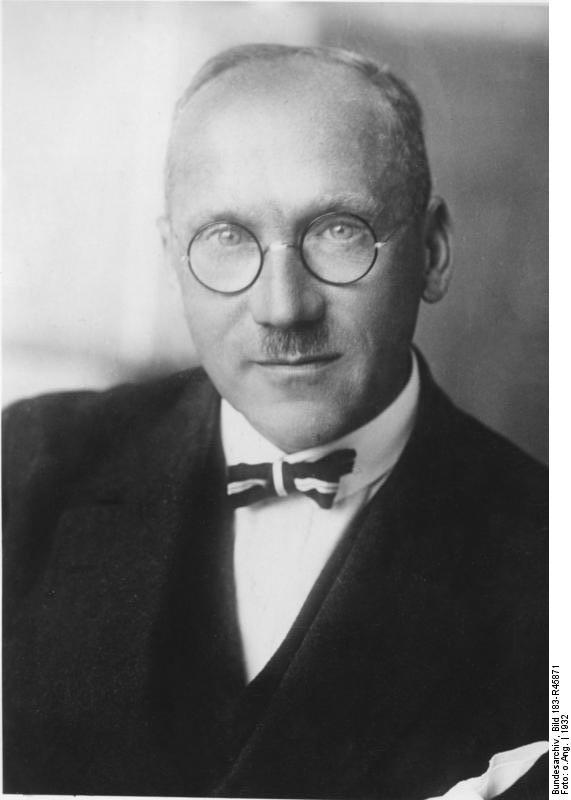
Ferdinand Sauerbruch (1875-1951)
On July 3, 1875, German surgeon Ernst Ferdinand Sauerbruch was born. He is considered as one of the most important and influential surgeons of the 20th century. He developed the Sauerbruch chamber, a pressure chamber for operating on the open thorax.
Ferdinand Sauerbruch – Early Years
Since his father, technical director of a cloth weaving mill, died early, Sauerbruch grew up with his grandfather, master shoemaker Friedrich Hammerschmidt. 1895 he passed the Abitur at the Realgymnasium in Elberfeld. In order to be able to study medicine, he took the Graecum examination at the old-language grammar school in Mülheim an der Ruhr in 1896. He then began his studies of natural sciences at the University of Marburg. He then moved to the Medical Faculty of the University of Leipzig, where – after a short study stay in Jena, where he joined the Borussia gymnastics club – he became a doctor in 1901.I n 1902 he received his doctorate under Heinrich Curschmann with a dissertation on a case of softening of the bones of children (title of the dissertation: A contribution to the metabolism of lime and phosphoric acid in infantile osteomalacia).
Reducing the Risk at Open Thorax Surgery
In the vicinity of Erfurt, he briefly worked as a country doctor before becoming an assistant in the surgical department at the Kassel Diakonissenkrankenhaus. In the same year he moved to the surgery department of the Erfurt hospital as an assistant, where he became first assistant physician in 1902. From 1903 Sauerbruch worked briefly at the Berlin-Moabit hospital and in the same year went to the Surgical University Hospital in Breslau, where, as Johannes von Mikulicz-Radecki‘s assistant, he founded thoracic surgery, i.e. open chest surgery, after several failures with the vacuum chamber (pressure difference procedure) developed by him. The method allowed heart and lung operations to take place at greatly reduced risk. There he was habilitated as a surgeon in 1905. He then moved to the University Hospital Greifswald.
Academic Career and World War I
Sauerbruch became senior physician in Marburg in 1908. Here he was appointed Associate Professor in the same year. From 1910 he was Professor of Surgery at the University of Zurich and Director of the Surgical Clinic and Polyclinic of the Cantonal Hospital Zurich. He volunteered at the outbreak of the first world war and was an advisory surgeon of the 15th Army Corps in 1914/15. From 1915 he headed surgery in Greifswald and, arriving from Zurich in each case, fitted prostheses to amputated soldiers in the “Vereinlazarett Singen”, where Sauerbruch developed several new types of limb prostheses, which for the first time enabled simple movements to be executed with the remaining muscle of the patient. He called for Halle and Königsberg. In 1918 he accepted a call to Munich. From 1918 to 1928 he was full professor at the University of Munich. In 1918 he became a privy councillor.
Nazi Germany and World War II
After the Munich Hitler coup of 8/9 November 1923, Sauerbruch treated the injured left shoulder of Adolf Hitler, who had fled from the police at Ernst Hanfstaengl’s Uffingen domicile. In 1928 he moved to the Charité in Berlin under exceptionally good conditions (1928-1949. With the rise of the Nazi Party, Sauerbruch participated in a letter supporting Adolf Hitler and was announced state council by Hermann Göring. Sauerbruch was appointed member of the ‘Reichsforschungsrat’ and approved various experiments presumably performed on prisoners of the concentration camps. Less than two weeks after the unconditional surrender of the Wehrmacht, the Soviet military administration in Germany created a magistrate for Berlin. They appointed Sauerbruch as city councillor for the health service.
Retirement
In the last years of his life he continued to work as an surgeon at the Charité and in a private clinic in Berlin-Grunewald. On December 6, 1949, the GDR newspapers reported: “Ferdinand Sauerbruch asked to release him from his position as professor at Humboldt University and head of the Surgical Clinic at Charité Berlin in the course of the general retirement of the over 70 year old teachers. The request was complied with.”
The End
During his active years as a surgeon, Ferdinand Sauerbruch became one of the most influential surgeons of the 20th century. Next to his work on the thorax medicine, Sauerbruch developed several prothesis including the so-called Sauerbruch Arm. To his patients also belonged Hanno Hahn, the son of Otto Hahn and Graf Schenk von Stauffenberg who was one of the leading members of the failed 20 July plot of 1944 to assassinate Adolf Hitler and remove the Nazi Party from power. Sauerbruch’s cheerful-melancholic memoirs were published in the year of his death. Ferdinand Sauerbruch, who suffered from a serious vascular disease and died one day before his 76th birthday as a result of his existing cerebral sclerosis
Pneumothorax – Spontaneous, Tension & Traumatic, [7]
References and Further Reading:
- [1] Ferdinand Sauerbruch Biography
- [2] Ferdinand Sauerbruch at Der Spiegel
- [3] Werner E. Gerabek: Ferdinand Sauerbruch. In: Neue Deutsche Biographie (NDB). Band 22, Duncker & Humblot, Berlin 2005, ISBN 3-428-11203-2, S. 459 f
- [4] Ferdinand Sauerbruch at Wikidata
- [5] Newspaper clippings about Ferdinand Sauerbruch in the 20th Century Press Archives of the ZBW
- [6] Works by or about Ferdinand Sauerbruch at German Digital Library
- [7] Pneumothorax – Spontaneous, Tension & Traumatic, Dr. Najeeb Lectures @ youtube
- [8] Dewey, Marc; Schagen, Udo; Eckart, Wolfgang U.; Schönenberger, Eva (2006). “Ernst Ferdinand Sauerbruch and His Ambiguous Role in the Period of National Socialism”. Annals of Surgery. 244 (2): 315–321.
- [9] Timeline of German Surgeons, via DBpedia and Wikidata






Pingback: Whewell’s Gazette: Year 3, Vol. #47 | Whewell's Ghost